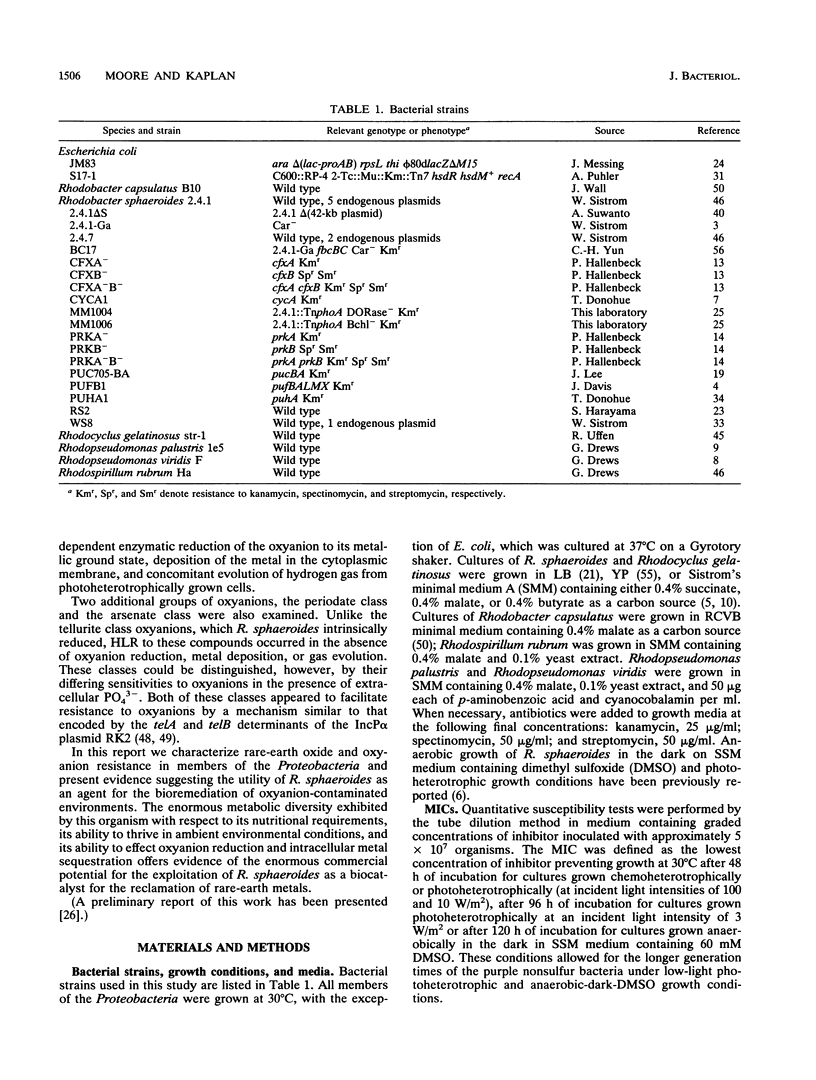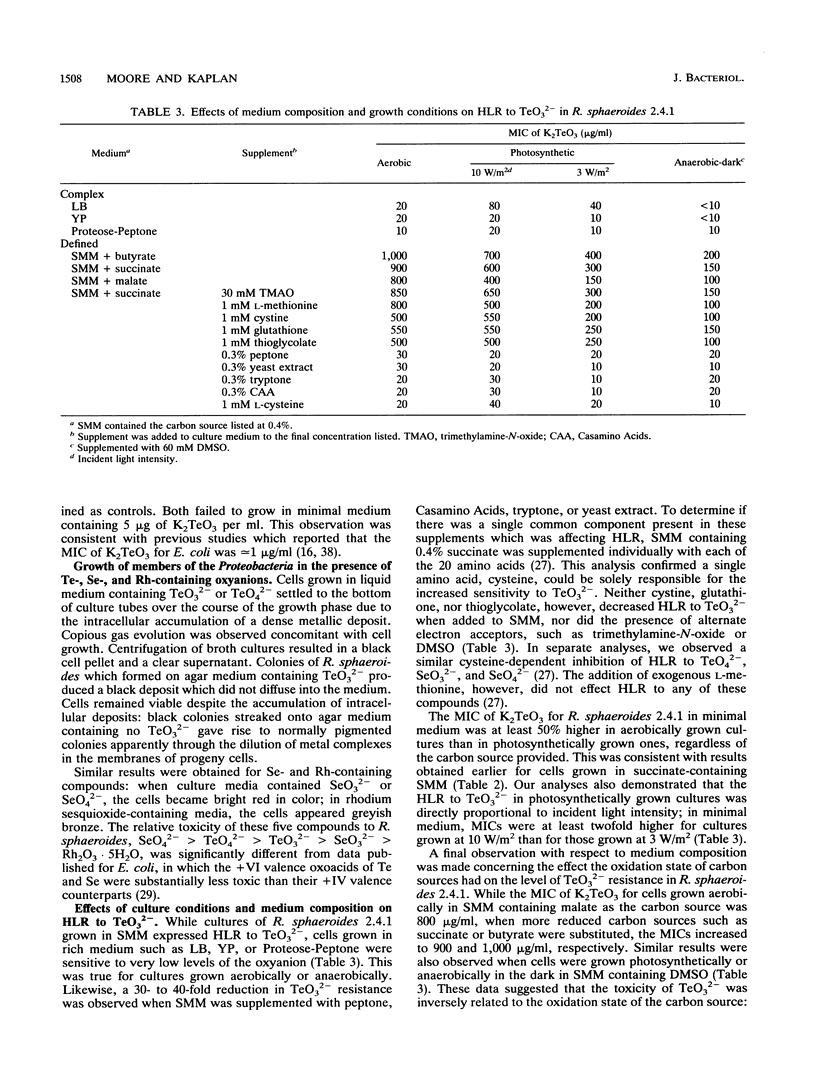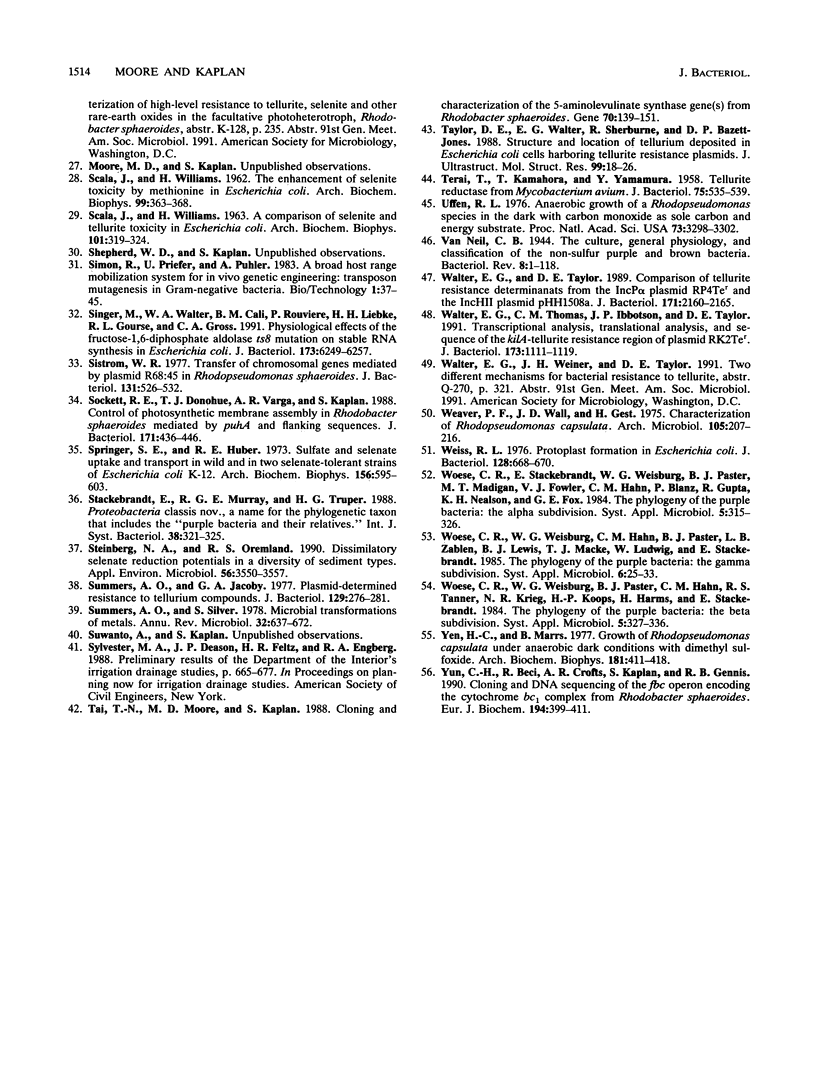Abstract
We have identified intrinsic high-level resistance (HLR) to tellurite, selenite, and at least 15 other rare-earth oxides and oxyanions in the facultative photoheterotroph Rhodobacter sphaeroides grown either chemoheterotrophically or photoheterotrophically. Other members of the class Proteobacteria, including members of the alpha-2 and alpha-3 phylogenetic subgroups, were also shown to effect the reduction of many of these compounds, although genera from the alpha-1, beta-1, and gamma-3 subgroups did not express HLR to the oxyanions examined. Detailed analyses employing R. sphaeroides have shown that HLR to at least one class of these oxyanions, the tellurite class (e.g., tellurate, tellurite, selenate, selenite, and rhodium sesquioxide), occurred via intracellular oxyanion reduction and resulted in deposition of metal in the cytoplasmic membrane. The concomitant evolution of hydrogen gas from cells grown photoheterotrophically in the presence of these oxyanions was also observed. HLR to tellurite class oxyanions in R. sphaeroides was not affected by exogenous methionine or phosphate but was reduced 40-fold by the addition of cysteine to growth media. In contrast HLR to the periodate class oxyanions (e.g., periodate, siliconate, and siliconite) was inhibited by extracellular PO4(3-) but did not result in metal deposition or gas evolution. Finally, we observed that HLR to arsenate class oxyanions (e.g., arsenate, molybdate, and tungstate) occurred by a third, distinct mechanism, as evidenced by the lack of intracellular metal deposition and hydrogen gas evolution and an insensitivity to extracellular PO4(3-) or cysteine. Examination of a number of R. sphaeroides mutants has determined the obligate requirement for an intact CO2 fixation pathway and the presence of a functional photosynthetic electron transport chain to effect HLR to K2TeO3 under photosynthetic growth conditions, whereas functional cytochromes bc1 and c2 were required under aerobic growth conditions to facilitate HLR. Finally, a purification scheme to recover metals from intact bacterial cells was developed.
Full text
PDF









Selected References
These references are in PubMed. This may not be the complete list of references from this article.
- COHEN-BAZIRE G., SISTROM W. R., STANIER R. Y. Kinetic studies of pigment synthesis by non-sulfur purple bacteria. J Cell Physiol. 1957 Feb;49(1):25–68. doi: 10.1002/jcp.1030490104. [DOI] [PubMed] [Google Scholar]
- Chen J. H., Gibson J. L., McCue L. A., Tabita F. R. Identification, expression, and deduced primary structure of transketolase and other enzymes encoded within the form II CO2 fixation operon of Rhodobacter sphaeroides. J Biol Chem. 1991 Oct 25;266(30):20447–20452. [PubMed] [Google Scholar]
- Chiong M., González E., Barra R., Vásquez C. Purification and biochemical characterization of tellurite-reducing activities from Thermus thermophilus HB8. J Bacteriol. 1988 Jul;170(7):3269–3273. doi: 10.1128/jb.170.7.3269-3273.1988. [DOI] [PMC free article] [PubMed] [Google Scholar]
- Davis J., Donohue T. J., Kaplan S. Construction, characterization, and complementation of a Puf- mutant of Rhodobacter sphaeroides. J Bacteriol. 1988 Jan;170(1):320–329. doi: 10.1128/jb.170.1.320-329.1988. [DOI] [PMC free article] [PubMed] [Google Scholar]
- Donohue T. J., Cain B. D., Kaplan S. Alterations in the phospholipid composition of Rhodopseudomonas sphaeroides and other bacteria induced by Tris. J Bacteriol. 1982 Nov;152(2):595–606. doi: 10.1128/jb.152.2.595-606.1982. [DOI] [PMC free article] [PubMed] [Google Scholar]
- Donohue T. J., McEwan A. G., Kaplan S. Cloning, DNA sequence, and expression of the Rhodobacter sphaeroides cytochrome c2 gene. J Bacteriol. 1986 Nov;168(2):962–972. doi: 10.1128/jb.168.2.962-972.1986. [DOI] [PMC free article] [PubMed] [Google Scholar]
- Donohue T. J., McEwan A. G., Van Doren S., Crofts A. R., Kaplan S. Phenotypic and genetic characterization of cytochrome c2 deficient mutants of Rhodobacter sphaeroides. Biochemistry. 1988 Mar 22;27(6):1918–1925. doi: 10.1021/bi00406a018. [DOI] [PubMed] [Google Scholar]
- Drews G., Giesbrecht P. Rhodopseudomonas viridis, nov. spec., ein neu isoliertes, obligat phototrophes Bakterium. Arch Mikrobiol. 1966 Mar 31;53(3):255–262. [PubMed] [Google Scholar]
- Firsow N. N., Drews G. Differentiation of the intracytoplasmic membrane of Rhodopseudomonas palustris induced by variations of oxygen partial pressure or light intensity. Arch Microbiol. 1977 Dec 15;115(3):299–306. doi: 10.1007/BF00446456. [DOI] [PubMed] [Google Scholar]
- Fraley R. T., Lueking D. R., Kaplan S. The relationship of intracytoplasmic membrane assembly to the cell division cycle in Rhodopseudomonas sphaeroides. J Biol Chem. 1979 Mar 25;254(6):1980–1986. [PubMed] [Google Scholar]
- Gerrard T. L., Telford J. N., Williams H. H. Detection of selenium deposits in Escherichia coli by electron microscopy. J Bacteriol. 1974 Sep;119(3):1057–1060. doi: 10.1128/jb.119.3.1057-1060.1974. [DOI] [PMC free article] [PubMed] [Google Scholar]
- Gibson J. L., Falcone D. L., Tabita F. R. Nucleotide sequence, transcriptional analysis, and expression of genes encoded within the form I CO2 fixation operon of Rhodobacter sphaeroides. J Biol Chem. 1991 Aug 5;266(22):14646–14653. [PubMed] [Google Scholar]
- Hallenbeck P. L., Lerchen R., Hessler P., Kaplan S. Phosphoribulokinase activity and regulation of CO2 fixation critical for photosynthetic growth of Rhodobacter sphaeroides. J Bacteriol. 1990 Apr;172(4):1749–1761. doi: 10.1128/jb.172.4.1749-1761.1990. [DOI] [PMC free article] [PubMed] [Google Scholar]
- Hallenbeck P. L., Lerchen R., Hessler P., Kaplan S. Roles of CfxA, CfxB, and external electron acceptors in regulation of ribulose 1,5-bisphosphate carboxylase/oxygenase expression in Rhodobacter sphaeroides. J Bacteriol. 1990 Apr;172(4):1736–1748. doi: 10.1128/jb.172.4.1736-1748.1990. [DOI] [PMC free article] [PubMed] [Google Scholar]
- Jobling M. G., Ritchie D. A. Genetic and physical analysis of plasmid genes expressing inducible resistance of tellurite in Escherichia coli. Mol Gen Genet. 1987 Jun;208(1-2):288–293. doi: 10.1007/BF00330455. [DOI] [PubMed] [Google Scholar]
- Jobling M. G., Ritchie D. A. The nucleotide sequence of a plasmid determinant for resistance to tellurium anions. Gene. 1988 Jun 30;66(2):245–258. doi: 10.1016/0378-1119(88)90361-7. [DOI] [PubMed] [Google Scholar]
- Kiffney P., Knight A. The toxicity and bioaccumulation of selenate, selenite and seleno-L-methionine in the cyanobacterium Anabaena flos-aquae. Arch Environ Contam Toxicol. 1990 Jul-Aug;19(4):488–494. doi: 10.1007/BF01059066. [DOI] [PubMed] [Google Scholar]
- LOWRY O. H., ROSEBROUGH N. J., FARR A. L., RANDALL R. J. Protein measurement with the Folin phenol reagent. J Biol Chem. 1951 Nov;193(1):265–275. [PubMed] [Google Scholar]
- Lee J. K., Kiley P. J., Kaplan S. Posttranscriptional control of puc operon expression of B800-850 light-harvesting complex formation in Rhodobacter sphaeroides. J Bacteriol. 1989 Jun;171(6):3391–3405. doi: 10.1128/jb.171.6.3391-3405.1989. [DOI] [PMC free article] [PubMed] [Google Scholar]
- Markwell M. A., Haas S. M., Bieber L. L., Tolbert N. E. A modification of the Lowry procedure to simplify protein determination in membrane and lipoprotein samples. Anal Biochem. 1978 Jun 15;87(1):206–210. doi: 10.1016/0003-2697(78)90586-9. [DOI] [PubMed] [Google Scholar]
- Meinhardt S. W., Kiley P. J., Kaplan S., Crofts A. R., Harayama S. Characterization of light-harvesting mutants of Rhodopseudomonas sphaeroides. I. Measurement of the efficiency of energy transfer from light-harvesting complexes to the reaction center. Arch Biochem Biophys. 1985 Jan;236(1):130–139. doi: 10.1016/0003-9861(85)90612-5. [DOI] [PubMed] [Google Scholar]
- Moore M. D., Kaplan S. Construction of TnphoA gene fusions in Rhodobacter sphaeroides: isolation and characterization of a respiratory mutant unable to utilize dimethyl sulfoxide as a terminal electron acceptor during anaerobic growth in the dark on glucose. J Bacteriol. 1989 Aug;171(8):4385–4394. doi: 10.1128/jb.171.8.4385-4394.1989. [DOI] [PMC free article] [PubMed] [Google Scholar]
- SCALA J., WILLIAMS H. H. A comparison of selenite and tellurite toxicity in Escherichia coli. Arch Biochem Biophys. 1963 May;101:319–324. doi: 10.1016/s0003-9861(63)80019-3. [DOI] [PubMed] [Google Scholar]
- SCALA J., WILLIAMS H. H. The enhancement of selenite toxicity by methionine in Escherichia coli. Arch Biochem Biophys. 1962 Dec;99:363–368. doi: 10.1016/0003-9861(62)90280-1. [DOI] [PubMed] [Google Scholar]
- Singer M., Walter W. A., Cali B. M., Rouviere P., Liebke H. H., Gourse R. L., Gross C. A. Physiological effects of the fructose-1,6-diphosphate aldolase ts8 mutation on stable RNA synthesis in Escherichia coli. J Bacteriol. 1991 Oct;173(19):6249–6257. doi: 10.1128/jb.173.19.6249-6257.1991. [DOI] [PMC free article] [PubMed] [Google Scholar]
- Sistrom W. R. Transfer of chromosomal genes mediated by plasmid r68.45 in Rhodopseudomonas sphaeroides. J Bacteriol. 1977 Aug;131(2):526–532. doi: 10.1128/jb.131.2.526-532.1977. [DOI] [PMC free article] [PubMed] [Google Scholar]
- Sockett R. E., Donohue T. J., Varga A. R., Kaplan S. Control of photosynthetic membrane assembly in Rhodobacter sphaeroides mediated by puhA and flanking sequences. J Bacteriol. 1989 Jan;171(1):436–446. doi: 10.1128/jb.171.1.436-446.1989. [DOI] [PMC free article] [PubMed] [Google Scholar]
- Springer S. E., Huber R. E. Sulfate and selenate uptake and transport in wild and in two selenate-tolerant strains of Escherichia coli K-12. Arch Biochem Biophys. 1973 Jun;156(2):595–603. doi: 10.1016/0003-9861(73)90310-x. [DOI] [PubMed] [Google Scholar]
- Steinberg N. A., Oremland R. S. Dissimilatory selenate reduction potentials in a diversity of sediment types. Appl Environ Microbiol. 1990 Nov;56(11):3550–3557. doi: 10.1128/aem.56.11.3550-3557.1990. [DOI] [PMC free article] [PubMed] [Google Scholar]
- Summers A. O., Jacoby G. A. Plasmid-determined resistance to tellurium compounds. J Bacteriol. 1977 Jan;129(1):276–281. doi: 10.1128/jb.129.1.276-281.1977. [DOI] [PMC free article] [PubMed] [Google Scholar]
- Summers A. O., Silver S. Microbial transformations of metals. Annu Rev Microbiol. 1978;32:637–672. doi: 10.1146/annurev.mi.32.100178.003225. [DOI] [PubMed] [Google Scholar]
- TERAI T., KAMAHORA T., YAMAMURA Y. Tellurite reductase from Mycobacterium avium. J Bacteriol. 1958 May;75(5):535–539. doi: 10.1128/jb.75.5.535-539.1958. [DOI] [PMC free article] [PubMed] [Google Scholar]
- Tai T. N., Moore M. D., Kaplan S. Cloning and characterization of the 5-aminolevulinate synthase gene(s) from Rhodobacter sphaeroides. Gene. 1988 Oct 15;70(1):139–151. doi: 10.1016/0378-1119(88)90112-6. [DOI] [PubMed] [Google Scholar]
- Taylor D. E., Walter E. G., Sherburne R., Bazett-Jones D. P. Structure and location of tellurium deposited in Escherichia coli cells harbouring tellurite resistance plasmids. J Ultrastruct Mol Struct Res. 1988 Apr;99(1):18–26. doi: 10.1016/0889-1605(88)90029-8. [DOI] [PubMed] [Google Scholar]
- Uffen R. L. Anaerobic growth of a Rhodopseudomonas species in the dark with carbon monoxide as sole carbon and energy substrate. Proc Natl Acad Sci U S A. 1976 Sep;73(9):3298–3302. doi: 10.1073/pnas.73.9.3298. [DOI] [PMC free article] [PubMed] [Google Scholar]
- Walter E. G., Taylor D. E. Comparison of tellurite resistance determinants from the IncP alpha plasmid RP4Ter and the IncHII plasmid pHH1508a. J Bacteriol. 1989 Apr;171(4):2160–2165. doi: 10.1128/jb.171.4.2160-2165.1989. [DOI] [PMC free article] [PubMed] [Google Scholar]
- Walter E. G., Thomas C. M., Ibbotson J. P., Taylor D. E. Transcriptional analysis, translational analysis, and sequence of the kilA-tellurite resistance region of plasmid RK2Ter. J Bacteriol. 1991 Feb;173(3):1111–1119. doi: 10.1128/jb.173.3.1111-1119.1991. [DOI] [PMC free article] [PubMed] [Google Scholar]
- Weaver P. F., Wall J. D., Gest H. Characterization of Rhodopseudomonas capsulata. Arch Microbiol. 1975 Nov 7;105(3):207–216. doi: 10.1007/BF00447139. [DOI] [PubMed] [Google Scholar]
- Weiss R. L. Protoplast formation in Escherichia coli. J Bacteriol. 1976 Nov;128(2):668–670. doi: 10.1128/jb.128.2.668-670.1976. [DOI] [PMC free article] [PubMed] [Google Scholar]
- Woese C. R., Stackebrandt E., Weisburg W. G., Paster B. J., Madigan M. T., Fowler V. J., Hahn C. M., Blanz P., Gupta R., Nealson K. H. The phylogeny of purple bacteria: the alpha subdivision. Syst Appl Microbiol. 1984;5:315–326. doi: 10.1016/s0723-2020(84)80034-x. [DOI] [PubMed] [Google Scholar]
- Yen H. C., Marrs B. Growth of Rhodopseudomonas capsulata under anaerobic dark conditions with dimethyl sulfoxide. Arch Biochem Biophys. 1977 Jun;181(2):411–418. doi: 10.1016/0003-9861(77)90246-6. [DOI] [PubMed] [Google Scholar]
- Yun C. H., Beci R., Crofts A. R., Kaplan S., Gennis R. B. Cloning and DNA sequencing of the fbc operon encoding the cytochrome bc1 complex from Rhodobacter sphaeroides. Characterization of fbc deletion mutants and complementation by a site-specific mutational variant. Eur J Biochem. 1990 Dec 12;194(2):399–411. doi: 10.1111/j.1432-1033.1990.tb15633.x. [DOI] [PubMed] [Google Scholar]
- van Niel C. B. THE CULTURE, GENERAL PHYSIOLOGY, MORPHOLOGY, AND CLASSIFICATION OF THE NON-SULFUR PURPLE AND BROWN BACTERIA. Bacteriol Rev. 1944 Mar;8(1):1–118. doi: 10.1128/br.8.1.1-118.1944. [DOI] [PMC free article] [PubMed] [Google Scholar]


